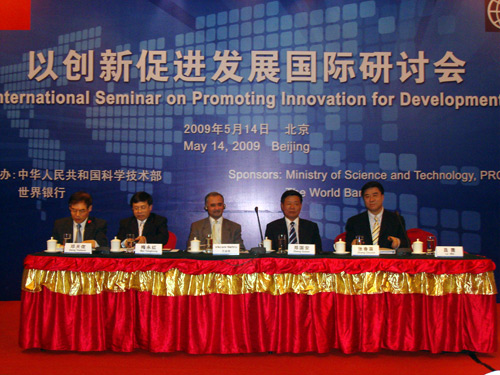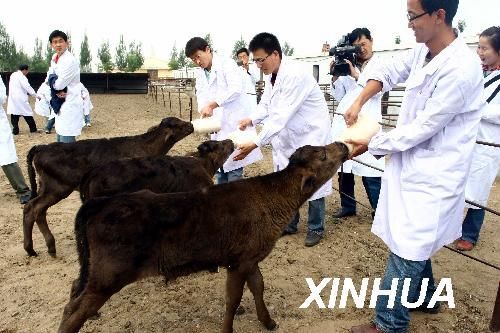|
CHINA SCIENCE AND TECHNOLOGY
NEWSLETTER
The Ministry of Science and Technology
People's Republic of China
|
|
|
N0.547 |
May 20, 2009 |
|
|
|
|
|
|
|
|
IN THIS ISSUE
|
|
* Major S&T Earmark Projects Accelerated
* Four Suggestions for China-US S&T Cooperation
* Seminar on Promoting Innovation for Development
* FY-3 Satellite Data Open to the Public
* Chip Telling H1N1 Drug Resistance
* Chinese Scientists Won Marconi Prize Paper Award
|
Major S&T Earmark Projects Accelerated
An routine cabinet meeting, chaired by Chinese Premier WEN Jiabao, was held on May 13, 2009 to accelerate the implementation of major S&T earmark projects, enhancing the support rendered by science and technology to stimulating the economic growth,
The meeting points out that science and technology should be a major player in supporting the strategy of expanding internal demand, promoting the growth, restructuring, raising to a higher level, and improving people’s livelihood. Science and technology is an important part of the package deal to respond to international financial crisis, and to facilitate a steady and relatively fast development of economy. At present stage, priority tasks have been defined for advancing and accelerating the implementation of major S&T earmark projects. State Treasury will make a package worth RMB 32.8 billion available to support the projects having a fine starting point and able to take full advantage of proprietary innovative findings derived from many-year R&D efforts, or having a fine market perspective and able to realize commercial applications within two or three years, playing a major role in promoting the current industrial development and expanding internal demand; or working to develop major technologies or products that will have a major impact on the future economic and social development. In 2010, RMB 30 billion will be made available for the purpose. Meanwhile, industry is encouraged to make its own R&D investment. Major S&T earmark projects will be mainly implemented in 11 areas, including high end programmed machine tools and basic manufacturing facilities, large airplane, new generation mobile telecommunication network, core electronic components, high end generic chips and basic software, super large integrated circuit manufacturing facilities and associated techniques, large oil/gas fields and coal mine development, advanced large pressurized water and high temperature gas cooling reactors, water body contamination control, new GM species, new drugs, and AIDS/viral hepatitis prevention and control. Additionally, a range of projects will be launched to demonstrate the applications of proprietary innovative products, accelerating the implementation of technology innovation projects, and nurturing new economic growth point.
|
INTERNATIONAL COOPERATION |
Four Suggestions for China-US S&T Cooperation
LIU Yandong, Chinese State Councilor, has recently met with a group of senior US officials in Washington, including Arne Duncan, Education Secretary, Steven Chu, Energy Secretary, Tom Vilsack, Agriculture Secretary, and John P. Holdren, the Science and Technology Advisor to President Barack Obama and Director of the White House Office of Science and Technology Policy. Both sides exchanged views on further strengthening the bilateral cooperation in the area of education and science/technology.
LIU told her American counterparts that both China and the United States have paid great attention to the development of education and science/technology, making enhancing the input in education and science/technology a major measure to respond to the current international financial crisis. Having reviewed the fruitful collaborations between the two countries in the area of science and technology in the past 30 years, LIU proposed the following suggestions for further strengthening S&T cooperation between the two countries: 1) consolidate and perfect S&T cooperation mechanisms between the two countries, taking full advantage of the role played by China-US joint committee for S&T cooperation; 2) strengthen the substantive cooperation in the area of energy, especially clean energy and renewable energy, adaptation to climate change impacts and environmental protection, agriculture science/technology, biopharmaceuticals, engineering technology, and basic research; 3) promote joint R&D activities of universities, research institutes, and industry in the two countries, and strengthen the collaborations in the area of mutual interest under the prerequisite of protecting intellectual property rights; and 4) enhance exchanges and cooperation between research institutes and scientists, especially young and middle aged scientists in the two countries.
Seminar on Promoting Innovation for Development

An international seminar on promoting innovation for development, co-sponsored by the Ministry of Science and Technology and the World Bank, was held on May 14, 2009 in Beijing. Participants, 80 in number, came from the People's Bank of China, China Banking Regulatory Commission, China Insurance Regulatory Committee, Securities and Exchange Commission, China Development Bank, the Export-Import Bank of China, Agricultural Development Bank of China, Bank of Communication, China Everbright Bank, provincial and municipal S&T departments, management committee of national high tech parks, university S&T parks, Ministry of Science and Technology, and the World Bank.
Participants heard the report on industrial innovations in China, which elaborated the accomplishments achieved in the area and challenges that Chinese industry is facing, and analyzed a range of related issues, including establishing an incentive mechanism to encourage innovations, enhancing the innovation capacity of private industry, and strengthening the venture capital investment system. Specialists, from Chinese government agencies, the World Bank, India, the UK, and the Netherlands, made keynote speeches on national innovation system, innovation capacity building of Chinese enterprises, innovation strategy of developing countries, innovation oriented fund raising activities in China, design of tech board listing, and development strategy for Chinese S&T enterprise incubators. The talk attracted great attention and profound discussion at the seminar. Participants said the meeting had introduced the experience both at home and abroad on how to promote industrial innovation, incubate S&T enterprises, and address the fund raising problems of small and medium-sized enterprises, which can be an important guidance to carrying out the same activities in China.
FY-3 Satellite Data Open to the Public
FY-3 weather satellite A, China’s new generation polar orbiting meteorological satellite, opened on May 15, 2009 its data storage and service system to the public. Both users and general public can download the data and products provided by FY-3 weather satellite via the data dissemination system, or a sharing website, or though the FTP server located on the premises of the National Satellite Meteorological Center. People may also get cloud image messages from the website when booked in advance. In addition to providing traditional search and download services, the new system is designed with an integrated space database, allowing space based distribution and purchase of satellite remote sensing data with the support of GIS platform. The system also furnish the data and products provided by 13 other weather satellites operated by European countries, the United States, and Japan, and the satellite meteorological data stored since April 1978.
National Satellite Meteorological Center also established a special data service agency equipped with technical and data service personnel, to provide manual data service and help for major disasters and research projects.
FY-3 weather satellite A has so far provided 2.23TB of real time satellite meteorological data to China and its adjacent areas since December 31, 2008.
H1N1 Viruses Separated and Sequenced
China Diseases Prevention and Control Center received on May 10, 2009 a throat swab specimen from Sichuan Diseases Prevention and Control Center. The specimen was confirmed H1N1 positive after RT-PCR and Real-time RT-PCR tests. The development made first confirmed H1N1 case in China.
Chinese National Flu Center separated the viruses through cell and egg inoculation. The separated viruses have been passed through for two generations. The H1N1 strains were separated on May 17, 2009 from first Chinese H1N1 patient, and named as A/sichuan/1/2009(H1N1)swl. Chinese scientists completed the genome sequence of H1N1 strains in the early morning of May 18, 2009. Sequence comparison and analysis shows that the viruses came from the same sources shared by the H1N1 viruses found in the United States. Tests also show that the strains are sensitive to neuraminidase inhibitors, such as Tamiflu.
Successful separation of H1N1 strains from Chinese patient provides the needed materials for further test and study, including developing the test kits and vaccine for the purpose, and studying the molecular epidemiologic part and spreading mechanism of the viruses. The genetic information of the viruses separated has been submitted to Genebank and GISAID for further analysis and monitoring in the global context.
Safe Mobile Laboratory
With the support of National 863 Program, the Chinese Academy of Military Medical Sciences has, together with collaborators, developed a mobile lab up to the grade III biological safety standard. The mobile lab has passed the approval check organized by the Ministry of Science and Technology and Ministry of Health. Made up of three modules for experiment, purification/technical support, and preparation, the new lab is designed to meet the grade III biological safety standard defined by Chinese authorities, with a comprehensive performance reaching an advanced level of its overseas counterparts, and better technical layout, major protection function, ventilation, and sewage treatment, compared with the latter. The new lab, designed to work independently to make a quick response to emergency events in a mobile manner, can promptly reach the designated site where public health events or bioterrorist attack take place, and work on the collection, storage, separation, cultivating, and testing of suspected pathogens. The Academy has developed a mass production capacity, allowing 6 mobile labs to be rolled out in three months.
Research Institutes Open to the Public
A ceremony was held on May 17, 2009 in Beijing to open domestic research institutes and universities to the public, a major initiative launched under the National Science Week. The opening ceremony of the National Animal Museum was held on the same occasion. Senior officials from the Ministry of Science and Technology, State Development and Reform Commission, Ministry of Environmental Protection, State Forestry Bureau, Chinese Academy of Sciences, China Association for Science and Technology, and National Natural Science Foundation were presents at the event. Under the initiative, research institutes and universities shall open to the public their research and experiment centers, including laboratories, engineering centers, instrument centers, natural resource banks, civic science facilities, observation sites, science museums, observatories, and botanic gardens.
Imaging the Impossible

Rat microvessels imaged
A team, led by XU Xuemin at Shanghai Jiaotong University School of Med-X, is working together with Shanghai Guangyuan Biomedical Imaging Station to establish a synchrotron medical imaging center. Together, researchers will develop innovative synchrotron radiation approaches, challenging the limit of live microvessels imaging. So far researchers have achieved noticeable progresses in imaging the microvessels in rat brains, allowing people to view live rat microvessels in several dozen microns.
Chip Telling H1N1 Drug Resistance
Institute of Radiation and Medical Radiation, part of Chinese Academy of Military Medical Sciences, has produced on May 15, 2009 a genetic chip able to tell the drug resistance of H1N1 viruses. According to a briefing, applied with proprietary nanomark signal amplifying technology, the proprietary chip is able to distinguish regular seasonal flu viruses from newly emerged flu viruses, in addition to its reliable detection of H1N1 viruses. The chip is also able to pick up the mutation site predicting the resistance to drugs, such as Tamiflu, and read out test results in 3-4 hours.
10 Million Kilowatts Wind Power
Gansu Province completed the planning at the end of 2007 to build a wind power center able to generate 10 million kilowatts of electricity in Jiuquan. The central government approved the planning in early 2008, for establishing a wind power center with a 5 million kilowatt capacity in 2010, and further to 12 million kilowatts in 2015. The project, made up of eighteen 200,000-kilowatt wind power generators and two 100,000-kilowatt generators, will be built by some 20 investors headed by Datang Gansu Grid. Up to date, a range of preparations, including the construction site for 3.8 million kilowatt wind power generation, environmental impact assessment, and wind turbine bidding, has been completed. The project will kick off its full-fledged construction upon the approval of the State Development and Reform Commission.
Pedigree Ox Cloned

Inner Mongolia University recently announced that a study team led by Dr. LI Guangpeng has cloned out 5 world-class pedigree calves. The animals were cloned from a fine pedigree ox bred out by XU Rigan, Vice President of the Chinese Academy of Engineering using the tube technology. Researchers obtained a tissue of 5-mm from the original ox, and made it to grow out a fetus through cloning, before transplanting the fetus in cows. 5 cloned calves were born with a respective weight of 21.2 kg, 59.5 kg, 32 kg, 45 kg, and 55 kg, enjoying a 100% survival rate. The successful cloning of pedigree species provides fine genetic resources for fast reproduction of quality beef, and laid a theoretical and technical foundation for fast beef breeding and GM animal breeding in the future.
Chinese Scientists Won Marconi Prize Paper Award
CHEN Wei and CAO Zhigang, lecturers at Tsinghua University Dept. of Electronics, have recently been granted with the IEEE Marconi Prize Paper Award, for their paper published in IEEE journal of Wireless Communications. In Unified Cross-Layer Framework for Resource Allocation in Cooperative Networks, a paper co-authored by the Award winner, a unified theoretical framework was proposed for a fair and effective cooperative network that can coordinate different algorithms and protocols. The paper that was granted with the IEEE Marconi Prize Paper Award for 2009 has gone through several rounds of review organized by both Communication Society and Signal Processing Society, part of IEEE, for its quality, originality, practicality, and timeliness.
Comments or inquiries on editorial matters or Newsletter content should be directed to:
Department of International Cooperation, MOST 15B, Fuxing Road, Beijing 100862, PR China Tel: (8610)58881360 Fax: (8610) 58881364
http://www.most.gov.cn |

